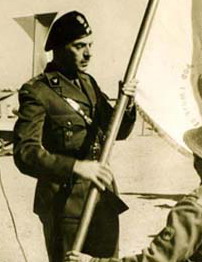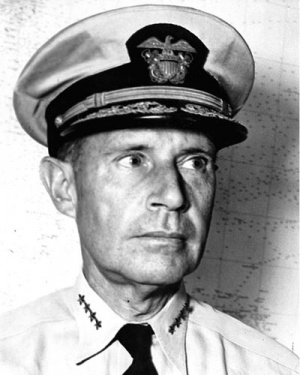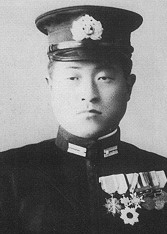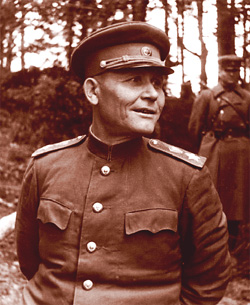That was a hard one as he was not a prominent public figure while he served for three years on the staff of Admiral Chester W. Nimitz, Commander in Chief, United States Pacific Fleet (CINCPAC), as Assistant Gunnery and Anti-submarine Training Officer. In addition, he analyzed actions and wrote CINCPAC’s war reports during the first part of this tour of duty.
(He had the rank of Captain during that time).
Ernest McNeill Eller (born in Marion, Virginia, on 23 January 1903 - died in Annapolis, Maryland on 30 July 1992), was a Rear Admiral in the United States Navy, who served as Director of Naval History, Naval History Division, Office of the Chief of Naval Operations from 1956 to 1970.
Naval career
Graduated and commissioned an Ensign on 4 June 1925, Eller rose to the rank of Captain in 1944, to date from 20 July 1943, and served in the temporary rank of Commodore from 30 September 1946 until 1 December 1947. On 1 April 1954 he was transferred to the Retired List of the US Navy as a Rear Admiral.
He served in USS Utah until 14 June 1926, when he reported to the Naval Torpedo Station, Newport, Rhode Island, for instruction. On 3 January 1927 he joined USS Texas and served on board that battleship until 28 May 1927. Following instruction in submarines at the Submarine Base, New London, Connecticut, he served successively from February 1928 to April 1932 in USS S-33 and USS Utah For the next three years he had duty at the United States Naval Academy in the Department of English and History and the Executive Department. During that period, he earned a Master of Arts degree in Psychology at George Washington University, Washington, DC.
During his next period of sea duty, he organized and conducted the Fleet Machine Gun School in USS Utah, in which he served until May 1938. He then returned to the Naval Academy for duty in the Departments of English and History, and Ordnance and Gunnery. From September 1940 until May 1941 he served as Assistant Naval Attaché in London, England, and as Observer with the British Home Fleet for radar, anti-aircraft, and other wartime technical developments.
After brief duty in the Fleet Training Division and Bureau of Ordnance, developing anti-aircraft training and weapons, he was ordered to USS Saratoga (CV-3), and served as her gunnery officer until May 1942. He was on board that aircraft carrier when she made her high-speed run from San Diego, California, to Pearl Harbor, Hawaii, with urgently needed plane and pilot replacements immediately after the Japanese attack on Pearl Harbor. He was also on board when USS Saratoga (CV-3) was torpedoed in January 1942 while on her third operational foray into the Marshall Islands and Midway Island areas.
[b]He served for the next three years on the staff Admiral Chester W. Nimitz, Commander in Chief, United States Pacific Fleet (CINCPAC), as Assistant Gunnery and Anti-submarine Training Officer. In addition, he analyzed actions and wrote CINCPAC’s war reports during the first part of this tour of duty.
He was awarded the Legion of Merit with Combat “V.” The citation follows in part:
For exceptionally meritorious conduct…while attached to the staff of the Commander in Chief, United States Pacific Fleet and Pacific Ocean Areas, during operations against enemy Japanese forces in the Pacific War Area from May 1942 to April 1945. Analyzing war reports and developing, expanding and supervising all types of training, particularly anti-aircraft, anti-submarine, amphibious and shore bombardment, (he) participated in landings on Makin and Okinawa and in other combat operations which led to improved methods and development of new weapons. In his constant attention to improvements in weapons and armament of his ships and in his supervision of Fleet ammunition supply, he rendered vital service in developing and maintaining the combat readiness of the Fleet…
During the summer and fall of 1945, he commanded the attack transport USS Clay, participating in three occupation moves into Japan and China. From late in December 1945 until March 1946, he served as District Public Information Officer, Twelfth Naval District, San Francisco, California. He reported in April 1946 to the Office of Public Information, Navy Department, Washington, DC, to serve as Deputy Director and on 31 July 1946 assumed the duties of Director of Public Information. He was promoted to the temporary rank of Commodore on 30 September 1946.[/b]
Selected to attend the course at the National War College, Washington, DC, which convened on 30 August 1948, he completed the course and reported in June 1949 for duty in the Staff Planning Section of the Joint Staff, Joint Chiefs of Staff. In this duty he accompanied the Joint Chiefs of Staff to the member countries of NATO establishing plans for the military structure of that organization. A year later, at the outbreak of the Korean War, he became Commander, Middle East Force, in the Persian Gulf – Indian Ocean area. He assumed command of USS Albany (CA-123) on 14 May 1951, and in April 1952 he was assigned to the Office of the Chief of Naval Operations, International Affairs Division. Late in 1953 he was hospitalized and on 1 April 1954 was transferred to the Retired List of the Navy.
On 15 September 1956 he was recalled to active duty as Director of Naval History, Naval History Division and Curator of the Navy Department, Washington, DC, and served as such until relieved of active duty on 23 January 1970.
This one is probably easier.
A prominent Italian political and military figure during the 1930’s and early WWII.







 )
)
